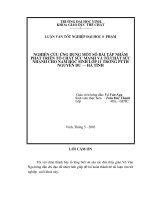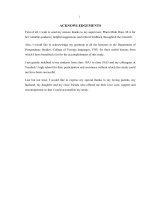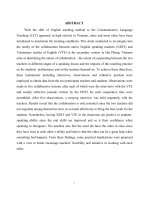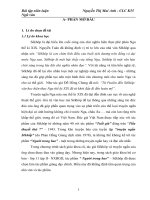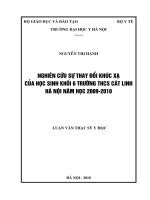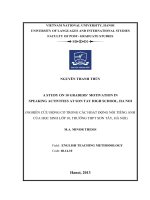Nghiên cứu hành động về tác động của phương pháp dạy viết dựa vào thể loại tới kỹ năng viết của học sinh lớp 11, Trường THPT Chuyên Tuyên Quang, Tỉnh Tuyên Quan
Bạn đang xem bản rút gọn của tài liệu. Xem và tải ngay bản đầy đủ của tài liệu tại đây (3.81 MB, 72 trang )
VIETNAM NATIONAL UNIVERSITY, HANOI
UNIVERSITY OF LANGUAGES AND INTERNATIONAL STUDIES
FACULTY OF POST-GRADUATE STUDIES
NGUYỄN NGỌC HÀ
THE IMPACT OF A GENRE-BASED APPROACH ON 11
TH
STUDENTS’ WRITING PERFORMANCE: AN ACTION
RESEARCH AT TUYEN QUANG GIFTED HIGH SCHOOL,
TUYEN QUANG
(Nghiên cứu hành động về tác động của phương pháp dạy viết
dựa vào thể loại tới kỹ năng viết của học sinh lớp 11, Trường
THPT Chuyên Tuyên Quang, Tỉnh Tuyên Quang)
M.A. MINOR PROGRAMME THESIS
Field: English Teaching Methodology
Code: 60.140.111
HANOI – 2013
VIETNAM NATIONAL UNIVERSITY, HANOI
UNIVERSITY OF LANGUAGES AND INTERNATIONAL STUDIES
FACULTY OF POST-GRADUATE STUDIES
NGUYỄN NGỌC HÀ
THE IMPACT OF A GENRE-BASED APPROACH ON 11
TH
STUDENTS’ WRITING PERFORMANCE: AN ACTION
RESEARCH AT TUYEN QUANG GIFTED HIGH SCHOOL,
TUYEN QUANG
(Nghiên cứu hành động về tác động của phương pháp dạy viết
dựa vào thể loại tới kỹ năng viết của học sinh lớp 11, Trường
THPT Chuyên Tuyên Quang, Tỉnh Tuyên Quang)
M.A. MINOR PROGRAMME THESIS
Field: English Teaching Methodology
Code: 60.140.111
Supervisor: Dr. Lê Văn Canh
HANOI – 2013
DECLARATION
I, NGUYEN NGOC HA, hereby certify that the thesis entitled ―The impact of a
genre-based approach on 11
th
students’ writing performance: An action research at
Tuyen Quang Gifted High School, Tuyen Quang” is my own study in the fulfillment
of the requirement for the Degree of Master of Arts at Faculty of Post-Graduate
Studies, University of Languages and International Studies, Vietnam National
University, Hanoi.
Hanoi 2013
Nguyen Ngoc Ha
ii
ABSTRACT
This research was carried out in an attempt to solve the problems of
students‘ poor writing performance at Tuyen Quang Gifted High School. A
hypothetical solution –the use of genre-based approach to teaching writing – was
tested in this study through a small-scale action research project.
This study was conducted in two cycles following the procedures of the
action research. In the first cycle, a questionnaire was administered to gain
information about the difficulties the students had been encountered with in
completing the writing tasks in the textbook. Then in the second phase, the genre-
based approach was experimented to teach writing to these students. By the time
the experiment terminated, another questionnaire was administered to the students
to find out their opinions on the usefulness and appropriateness of the genre-based
approach to their learning to write. Students‘ writings were also analysed to
complement the questionnaire data and to measure the impact of the treatment
upon students‘ writing.
The results showed that students did make progress in their writing, and
students‘ opinions were positive about the treatment.
iii
ACKNOWLEDGMENTS
I owe special debts of gratitude to my lectures, colleagues, family, friends
and my students for their support in my completing the thesis.
First of all, I would like to express my deepest gratitude to my supervisor,
Dr. Le Van Canh for his crucial advice, critical comments, invaluable suggestion
and also his devoted lessons.
I take this opportunity to thank all the lecturers of the Post Graduate
Faculty of University of Languages and International Studies, Vietnam National
University, Hanoi for their scholarly knowledge and amazing lectures that have
helped to increase my interest for English Methodology and my teaching job. My
special thanks are dedicated to Assoc Pro. Dr. Le Hung Tien, Nguyen Quynh
Trang, M.A whose lectures have inspired my interest in Research Methodology.
I would also like to thank the library staff for being so helpful and
supportive.
I would like to extend my thanks to my 11
th
grade students at Tuyen Quang
Gifted High School, Tuyen Quang Province for their willingness to help me
complete my thesis.
Finally, my heartfelt sense of gratitude goes to my family for their
emotional support in accomplishing this graduation thesis.
Nguyen Ngoc Ha
iv
TABLE OF CONTENTS
DECLARATION 1
ABSTRACT ii
ACKNOWLEDGMENTS iii
TABLE OF CONTENTS iv
LIST OF FIGURES AND TABLES vii
LIST OF CHARTS viii
LIST OF APPENDICES ix
PART A: INTRODUCTION 1
1. Rationale for the research 1
2. Aims and objectives of the research 1
3. The research questions 2
4. Method of the research 2
5. Structure of the thesis 2
PART B: DEVELOPMENT 4
CHAPTER 1 4
LITERATURE REVIEW 4
1. 1. Why focus on writing? 4
1.2. Approaches to teach writing 5
1.2.1. The product approach 6
1.2.2. The process approach 7
1.2.3. The genre-based approach 9
1.2.3.1. Definition of a genre 9
v
1.2.3.2. Genre-based approach: 10
1.3. Review of the related studies 14
CHAPTER 2: METHODOLOGY 16
2.1. Rationale of the using action research 16
2.2. Research setting 16
2.2.1. Overview 16
2.2.2. Writing tasks in the textbook Tieng Anh 11 16
2.2.3 Selection of participants 17
2.3. The Research Design 17
2.4. The teaching cycle used in this study 18
2.5. Methods of data collection and analysis 19
2.5.1. Methods of data collection 19
2.5.2. Data analysis 21
CHAPTER 3: FINDINGS AND DISCUSSION 22
3.1. The results of phase I 22
3.1.1. Analysis of students’ general information 22
3.1.2. Analysis of the difficulties students had encountered 24
3.1.3. Analysis of students’ expectation of new teaching approach 26
3.2. The results of phase II 27
3.2.1. The results of the students’ writing test 27
3.2.1.1. The performance of students in the content of the writing test 28
3.2.1.2. The performance of students in the organization of the writing test 28
vi
3.2.1.3. The performance of students in using the vocabulary of the writing test 29
3.2.1.4. The performance of students in using the language 29
3.2.1.5. The performance of students in using the mechanics 30
3.2.2. The results of the writing samples 31
3.2.3. The results of the questionnaire for students after the teaching cycle 32
3.2.3.1. The strengths and weakness of this genre-based approach 32
3.2.3.2. Students’ self-report on their reduced difficulties 34
3.2.3.3. The things they have learned from this approach in writing 34
3.2.3.4. If they want to continue this genre-based approach in writing in the
next semester 35
3.2.3.5. The necessary conditions for each student to write better 35
PART C: CONCLUSION 37
1. Summary of major findings 37
2. Concluding remarks 38
3. Plan for the next research cycle 40
REFERENCES 41
APPENDICES
vii
LIST OF FIGURES AND TABLES
Figure 1: Martin‘s models of genre
Table 1- The overall results of students‘ writing tests
Table 2- Students‘ performance in the organization of the writing tests
Table 3- Students‘ self report on their reduced difficulties
Table 4-Students‘ responses on their wanting to continue with new
approach
Table 5- Students‘ responses on the necessity for each student
viii
LIST OF CHARTS
Chart 1- Students‘ duration of studying English
Chart 2- Students‘ perceived difficulty of writing in comparison with other
language skills
Chart 3- Students‘ self assessment of their writing competence
Chart 4- Students‘ difficulties to encounter
Chart 5- Students‘ expectation of the new approach
Chart 6- Students‘ performance in the content
Chart 7- Students‘ performance in using the vocabulary
Chart 8- Students‘ performance in using the language
Chart 9- Students‘ performance in using the mechanics
Chart 10- Students‘ responses on the strengths and weaknesses of new approach
Chart 11- Students‘ responses on the things they gained from new approach
ix
LIST OF APPENDICES
Appendix 1: The writing tasks in textbook Tieng Anh 11
Appendix 2: Model texts to teach the aspects of a recount
Appendix 3: Activities to build the field
Appendix4: Modeling
Appendix 5: Questionnaire to investigate the difficulties of students in writing
Appendix 6: The first writing sample
Appendix 7: The second writing sample
Appendix 8: The writing test
Appendix 9: Survey questionnaire for students to find out the appropriateness of
the new approach
Appendix 10: Marking scheme
Appendix 10.1: Marking scheme for writing
1
PART A
INTRODUCTION
1. Rationale for the research
Writing is one of the four skills that are mandated in the English textbooks for
high school students. However, the writing competence leaves much to be desired.
Students find it too challenging to write well while teachers feel frustrated.
The question is ―how can teachers help to improve students‘ writing in the
context of a high school in a mountainous area?‖. Through reading the literature, I
was impressed by the idea of teaching writing through a genre-based approach.
However, the literature review also showed me that this approach to writing was
little researched in Vietnamese high schools. So, I decided to experiment this
approach to my teaching writing to my own students in my school. The aim of this
action research is to examine whether a genre-based approach to writing is helpful to
my students or not.
2. Aims and objectives of the research
The research is aimed at investigating students‘ attitudes towards the genre-
based approach, which was new to them, and examining whether this teaching
approach helped students to make progress in their writing performance.
In order to achieve these aims, the following objectives were set out for the
study:
1. To gain understanding of what students like and dislike about the genre-based
approach to teaching writing;
2. To identify the extent to which this new approach to teaching writing helped
the students to improve their writing performance.
The research focused only on the students‘ difficulties in learning the writing
skill and the impact of genre-based approach to their writing performance at
2
Tuyen Quang Gifted High School, Tuyen Quang, Vietnam. The research lasted for
5 weeks and the treatment was applied to all students in a classroom. The research
mainly focused on 11
th
form students majored in Mathematics.
3. The research questions
In order to achieve the aims and objectives of the study as presented in section 2,
the following research questions were raised:
1. What are the students’attitudes towards learning to write in English with the
genre-based approach?
2. To what extent does the use of the genre-based approach help to improve my
students’ writing performance?
4. Method of the research
Quantitative methods were used in this action research. To be more
specific, the questionnaire was an instrument that was applied for collecting the
data. Questionnaire responses were analysed by means of descriptive statistics. This
research method was aimed at providing information on students‘ attitudes towards,
and opinions about, the genre-based approach that their teacher (also the researcher)
used. In addition to the questionnaire, students‘ writings were collected and
analysed throughout the treatment period to measure the students‘ progress in their
writing performance.
5. Structure of the thesis
This thesis is divided into three main parts:
Part I is the INTRODUCTION. In this part, the rationale of the research, the aims,
objectives, research questions, methods of the research, and also its design
Part II is the DEVELOPMENT which includes 3 smaller chapters. Chaper I deals
with some theoretical background that is relevant to the purpose of the study.
Chapter II describes the situation where the research was conducted and the
informants involved in the research. It includes the writing tasks in the textbook,
3
research design, the teaching cycle in the study. The method of data collection and
its procedures. Chapter III presents the results found out about the impact of
genre-based approach to the 11th form students‘ writing performance. This
chapter is by far the most dominant one
Part III is the CONCLUSION which includes the major findings, concluding
remarks and plan for the next research cycle.
APPENDICES and REFERENCES are presented in the last pages of the research.
4
PART B: DEVELOPMENT
CHAPTER 1
LITERATURE REVIEW
Since its commencement in Sydney, Australia in 1980s, genre-based approach to
teaching language in general and teaching writing in particular has gained
considerable prominence. Although there are many factors contributing to the
preference of applying this approach, this review will focus on three main factors
that make genre-based approach outweigh the previous ones, i.e. product approach
and process approach. These factors lie in the connection between classroom
writing tasks and real life contexts and purposes, the exposure of learners to a
variety of genres, and the effective assistance for learners to come out with well-
organized and readable pieces of writing for the intended readers, i.e. the English
discourse community.
1. 1. Why focus on writing?
Writing is much more than the transcription of speech. A first reason for focus
on writing is that it is in attempting to communicate in this new mode that children
most effectively discover and master the relationship between speech and written
text. When children first learn to write, they say something first and then write it
down, they quickly discover that the two modes of communication are organized on
different principles. In order to make one‘s meaning clear for others, one must first
make it clear for oneself. Writing creates a permanent representation of meaning
whatever the field or discipline concerned. As such the text can become the focus of
discussion within the community.
Trible (1996, p7) made a list of reason for school students and adults learners to
include writing in their study. It seems that both target groups enjoy great benefits
from writing such as language practice opportunities, accuracy improvement, job
enhancement and better exam results. Ronald White (1981) considered that writing
5
is essential in any English program because it has a number of usages. Firstly, it has
high face value in the role of the commonest way of examining student performance
in English. Therefore, it can offer tangible results to parents, students and teachers.
Secondly, many writing activities and techniques bring variety and interest to the
lesson. Last but not least, writing is a reliable test device for teachers to collect
information about their students‘ progress, not only to evaluate, but rather to
provide feed-back on what the students have learnt.
In conclusion, for school students who study a second or foreign language,
writing has current immediate values, including language practice and EFL
examination. Also it embeds future values such as professional benefits,
development of creative language and educational values. Therefore, EFL teachers
should foster the needs of particular learners to take advantages of writing.
1.2. Approaches to teach writing
Among the four communicative skills writing is considered to be the most
challenging learners expected to master. An ability to write appropriately and
effectively is a task that most ESL learners faced in spite of the years spent learning
and developing their writing skills. Writing is complex and multifaceted in nature.
Therefore, helping students to write better is also a challenge to the teacher. In the
literature, a variety of approaches to the teaching of writing have been introduced
and applied to facilitate the writing classes. Although there are a great number of
such approaches, three of which are cited for their prominence in teaching writing.
They include the product approach, the process approach and the genre-based
approach. As a matter of fact, each approach has its own advantages and
disadvantages and is suitable for a particular context of learning and teaching EFL.
Nonetheless, this action research will largely focus on the genre-based approach and
its impact on the teaching of writing to high school students.
6
1.2.1. The product approach
The product approach is the traditional approach to teaching writing which
focuses on the form and content of the finished writing products, i.e. the paragraph,
letter, an essay. The writing teachers who subscribe to the product approach are
more concerned to see what a final piece of writing will be like and measure it
against criteria of ―vocabulary use, grammar use, and mechanical considerations
such as spelling and punctuations‖, as well as content and organization. Clark
(2003, p4) described how the approach realized in a writing class: ―Learning to
write in those days meant being able to figure out what the teacher wanted in order
to create an acceptable product, and apparently few teaches thought that helping
students acquire a workable writing process was part of their job. Whatever
process students used, they had to manage on their own.”
A model for such an approach is outlined below:
Stage 1: Analyzing the features of the model written text. For instance, if studying a
story, the focus may be on the techniques used to make the story interesting, and
students focus on where and how the writer employs these techniques.
Stage 2: The controlled practiced of the highlighted features, usually in isolation.
Stage 3: Organization of ideas. Those who are in favour of this approach believe
that the organization of ideas is more crucial than the ideas and as crucial as the
control of language.
Stage 4: The end of the learning process, students choose from a choice of
comparable writing tasks. Individually, they use the skills, structures and
vocabulary they have been taught to produce the product to show what they can do
as fluent and competent users of the language.
Due to its primary focus on the finished products, the product approach was
attacked by many criticisms. Trible (1996, p.37) wrote, ―in that context [using
product approach], one of the trash’s main role will be instill notions of correctness
7
and conformity”. Pincas (1982a:24) sees learning as assisted imitation, and adopts
many techniques where learners respond to a stimulus provided by the teacher.
However, her comment that, at the stage of free writing (stage 4), ―student should
feel as if they are creating something of their own‖.
The weaknesses of product approaches are that process skills, such as planning
a text, are given a relatively small role, and that the knowledge and skills that
learners bring to the classroom are undervalued. Their strengths are that they
recognize the need for learners to be given linguistic knowledge about texts, and
they understand that imitation is one way in which people learn.
In short, product-based approach sees writing as mainly concerned with
knowledge about the structure of language, and writing development as mainly the
result of the imitation of input, in the form of texts provided by the teacher.
1.2.2. The process approach
The process approach to writing was an approach which emerged in the 1960s.
Trible suggests that process approach stress writing activities which move learners
from the generation of ideas and the collection of data through to the ―publication‖
of a finished text. (1996:37)
The idea of writing as a process was initially introduced at the Conference of
College and Communication in 1963. The conference was the generation of a
process approach to composition and a new research area that focused on
understanding how people write and learn to write. This was ―writing is a process,
not a product‖. It was warmly welcomed by many researchers who developed a
number of process methods and techniques.
Writing in process approach is seen as predominantly to do with linguistic
skills, such as planning and drafting, and there is much less emphasis on linguistic
knowledge, such as knowledge about grammar and text structure.
8
There are different views on the stages that writers go through in producing a
piece of writing, but a typical model identifies four stages: prewriting,
composing/drafting, revising, and editing. The pre-writing activity would involve
introducing techniques that help the students discover and engage a topic. Instead of
turning in a finished product right away, students are asked for multiple drafts of
work. After discussion and feed-back from readers, the learners would revise the
drafts. Rewriting and revision are integral to writing, and editing is an on-going
multiple-level process. In such writing classroom, the central elements are the
writer, the content and the purpose, and multiple drafts. The teacher in a process-
approach classroom becomes the facilitator. Writing is essentially learned, not
taught. Providing input or stimulus for learners is perceived as unimportant, since
the teacher‘s task is only to facilitate the exercise of writing skills and draw out the
learners‘ potential.
In recent years, however, the process approach has come under serious and
thorough examination. The approach has a somewhat monolithic view of writing as
Badger and White (2000) stated. ―The disadvantages of process approaches are
that they often regard all writing as being produced by the same set of processes;
that they give insufficient importance to the kind of texts writers produce and why
such texts are produced; and that they offer learners insufficient input, particularly
in terms of linguistic knowledge, to write successfully.”. Atkinson (2003) gives his
comments: ―The process approach seems to narrowly focus on the skills and
processes of writing in the classroom itself and as a result fails to take into account
the social and cultural aspects that have an impact on different kinds of writing”.
Johns (1995), for instance, strongly expresses her view against the process
movement: ―This movement’s emphasis on developing students as authors when
they are not yet ready to be second language writers, in developing students voice
while ignoring issues of register and careful argumentation, and in promoting the
author’s purposes while minimising understandings of role, audience and
community have put our diverse students at a distinct disadvantage…”
9
In short, the process approach describes writing as a multi-stage process that the
writers have to go through. It may include prewriting, planning, responding,
revising, editing, evaluating, and post-writing. Good writers will follow these stages
in a recursive order, which requires their re-visit of any stage during their writing
process. The process shows that writers should have some communication while
writing to make it a real activity.
1.2.3. The genre-based approach
1.2.3.1. Definition of a genre
An Australian genre theorist as Martin (1993, p.13) have defined genres as
staged goal oriented social processes through which social subjects in a given
culture live their life. Callaghan and Rothery (1988p.25) explain three elements in
the definition in detail: ―Genres are defined as social processes because members of
a given culture have learned to use them in an interactive social setting. They are
goal oriented because they have evolved to allow people in the culture to achieve
their goals; to get things done. They are staged and have a distinctive beginning,
middle and end structure which is the means for people achieving their goals.
Swale (1990, p.58) defines a genre as ―a class of communicative events, the
member of which share some sets of communicative purposes. These purposes are
recognised by the expert members of the parent discourse community, and thereby
constitute the rationale for the genre. This rationale shapes the schematic structure
of the discourse and influences and constrains choice of content and style.‖ As
pointed out by his definition, each piece of writing serves a particular
communicative purpose within a certain social context and is governed by rules or
conventions.
Genres are also influenced by other features of the situation, such as the subject
matter, the relationships between the writer and the audience, and the pattern of
organization. Martin (1993: 120) offers a diagrammatic explanation of genre.
10
Purpose
(Genre)
Channel Subject matter Interlocutor Relationship
(Mode) (Field) (Tenor)
Text
Figure 1- Marin’s models of genre
Hoey (2001) likens readers and writers to dancers following each other‘s steps,
each assembling sense from a text by anticipating what the other is likely to do by
making connections to prior texts. While writing, like dancing, allows for creativity
and the unexpected, established patterns often form the basis of any variations. We
know immediately, for example, whether a text is a recipe, a joke, or a love letter
and can respond to it immediately and even construct a similar one if we need to. As
teachers, we are able to engage in more specialised genres such as lesson plans,
student reports, and feedback sheets, bringing a degree of expertise to the ways we
understand or write familiar texts. In more precise terms, we possess a schema of
prior knowledge which we share with others and can bring to the situations in which
we read and write to express ourselves efficiently and effectively.
1.2.3.2. Genre-based approach: is the approach in which students are explicitly
exposed to the language features, text structures and the social purposes of each text
type. Then, students step by step produce the text with appropriate scaffolding of
the teacher.
At the heart of the approach, therefore, is the view that writing pedagogies
should ―offer students explicit and systematic explanations of the ways language
functions in social contexts‖ (Hyland, 2003). A range of methods is employed in a
classroom using the genre approach. For instance, Paltridge (2001) proposes a
11
framework that involves investigating the texts and contexts of students‘ target
situations, encouraging reflection on writing practices, exploiting texts from
different types of genre and creating mixed genre portfolios. The underpinning
theory of such a pedagogical approach, according to Vyotsky (1978), as reported in
Hyland (2003a), is an ―emphasis on the interactive collaboration between teacher
and student, with the teacher taking an authoritative role to ‗scaffold‘ or support
learners as they move towards their potential level of performance.
Genre-based approach promises very benefits for learners as they pull together
language, content, and contexts, while offering teachers a means of presenting
students with explicit and systematic explanations of the ways writing works to
communicate. Hyland (2003a, pp10-16) says about the genre-based approach:
―Perhaps, the most important feature is that genre-based writing instruction offers
students an explicit understanding of how target texts are structured and why they
are written in the ways they are. This explicitness gives teachers and learners
something to shoot for making writing outcomes clear rather than relying on hit or
miss inductive methods whereby learners are expected to acquire the genres they
need from repeated writing experiences or the teacher’s notes in the margins of
their essays”
For teachers, genre-based approach not only addresses the needs of ESL writers
but also draws teachers into considering how texts actually work as communication.
Teachers of writing clearly need to be teachers of language as it is necessary to
exercise appropriate linguistic choices in the ways they treat and organize their
topics for particular readers which helps students to give their ideas authority. By
categorizing and analyzing the texts they ask students to write, teachers become
more familiar with the ways meanings are created and more sensitive to the specific
communicative needs of their students. Teachers are therefore in a better position to
reflect on their own writing and that of their students, offering them a means to
understand, deconstruct, to make decisions about the teaching methods and
12
materials to use, and to approach current instructional examples with a more critical
eye.
Derewianka (1990) indicates that in order for learners to learn to write a
specific genre, teachers and learners work through a cyclical process which consists
of four stages, namely Building the Field, Modeling, Joint Construction and
Independent Writing. The first stage is intended to give students time to gather
information about what they will be writing. Then, in Modeling, they are exposed to
an authentic text of a particular genre to familiarize with its generic structure,
language features and communicative purpose. Then with the help of their teacher,
they jointly construct a text. Joint writing allows students to experience the
processes of thinking and social interaction in writing by observing how meanings
and language are chosen to serve a particular communicative purpose and by
participating in the decision making which mould them into more confident writers.
Finally, students write the text of the same genre on their own.
The principles of the genre based approach are realized in the teaching and
learning cycle or model. The teaching model consists of a number of stages that the
teacher and students go through so that students gradually gain independent control
of a particular genre. The stages usually come in circle to indicate that there are
different points of entry depending on the needs of the students.
Each of these stages therefore seeks to achieve a different purpose, and as a
result, is associated with different types of classroom activities and different
teacher–learner roles. The cycle is one way of understanding the Five E‘s concept
long familiar in science teaching, helping learners to engage, explore, explain,
extend, and evaluate (given by Trowbridge & Bybee, 1990). The cycle is intended
to be used flexibly, allowing students to enter at any stage depending on their
existing knowledge of the genre and to enable teachers to return to earlier stages of
the cycle for revision purposes.
13
A key purpose of the cycle is to ensure repeated opportunities for students to
engage in activities which require them to reflect on and critique their learning by
developing understandings of texts, acting on these through writing or speaking,
reviewing their performance, and using feedback to improve their work. The model,
therefore, allows vocabulary to be recycled and the literacy skills gained in previous
cycles to be further developed by working through a new cycle at a more advanced
level of expression of the genre.
The examples of genres would be narrative, recount, explanation, information
report, exposition, procedure. In teaching from the genre-based approach, the four
part cycle is proposed. This involves:
a. Building the context :
- Brainstorming, discussions and opportunities to reveal relevant personal
experiences.
- Vocabulary development
b. Modeling / deconstruction the text
According to Derewianka (1992:p7), if learners are to write in a particular
genre, they first need to become familiar with its purpose and features through
rich exposure in the genre. This is achieved as follows:
Introduce a model of the genre to the class
Discuss the purposes for which we use this genre in our society (i.e. the
purpose of a recount is to tell what happened)
With the class identify how the text is structure. Each genre has a distinctive
set of stages which help it to gain its purpose.
Discuss the function of each stage.
c. Joint construction of the text
- Before students write independent texts, it is useful for them to participate in the
group writing of a text in the chosen genre. A text may be jointly constructed by the
whole class, by a small group, or by a teacher and learner during conference.
14
-As well as demonstrating what form the final product may take, the joint
construction of a text should also demonstrate the process involved in writing a text.
d. Independent construction of the text
-Having read and examined the example texts in the chosen text and having
experienced of joint-constructing a similar text, students now are ready to choose
the own texts on a related topic.
In addition to providing teachers with a way of organizing their courses, genre
based writing instruction follows modern theories of learning in giving
considerable recognition to the importance of collaboration, or peer interaction,
and scaffolding, or teacher-supported learning.
In short, while study genre-based approach students move backwards and
forwards through alternate processes of induction and deduction, between language
and meta-language, activity and received knowledge, experience and theory.
That‘s why the aim of teaching genre to grade 11 students in my school would
empower them to write a variety of purposes and audiences. So writing should be
taught as how it can be used in context meaningfully.
1.3. Review of the related studies
By conducting observation of the two teachers in Indonesia when TIASARI (an
Indonesian teacher) did the action research on knowing about the use of literacy
approach to teach recount text to the first grade of senior high school, he found out
that the two teachers didn‘t know about what to do in Building the field, couldn‘t
fully make use of all their cognitive and affective abilities. Although they practiced
using English for a Better Life textbook to teach literacy approach in recount text,
they were still confused to apply in their classroom.
To stimulate the students‘ writing skill, especially writing recount text, the
researcher, Setyani (2008) conducted a classroom action research using headline
news. The students can get the headline news from the newspapers or magazines or
television. From these media, the students can make news in English. So writing
headline news will help the students in writing recount text. Therefore, the main

